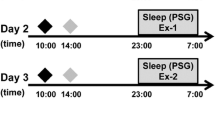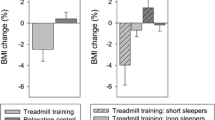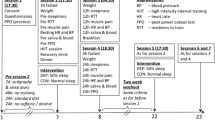Summary
We investigated the effect of a 12-week physical training programme on the sleep of nine unfit women. Data were collected at 0, 4, 8 and 12 weeks of the training programme. Changes in fitness were assessed by changes in maximal oxygen consumption (\(\dot V_{O_{2\max } } \)) and onset of blood lactate turn point (LTP). Lean body mass (LBM) was calculated from total body potassium measurements. The all-night sleep recordings were made following days during which the subjects carried out their normal daily routines and did no extra exercise. Although cardiorespiratory fitness improved significantly as indicated by an increase in both\(\dot V_{O_{2\max } } \) and LTP, there was no change in LBM. The improvement in cardiorespiratory fitness did not result in any changes in the sleep parameters measured. Other workers have reported an improvement in sleep quality in eight army recruits during their basic training. The male recruits showed improved cardiorespiratory fitness and an increase in muscle bulk. These results suggest that increased fitness only facilitates sleep when there is an associated increase in LBM. Alternatively it may be that the response of sleep to improved fitness is sex-linked.
Similar content being viewed by others
References
Adam K (1977) Body weight correlates with REM sleep. Br Med J no. 6064:813–814
Agnew HW, Webb WB, Williams RL (1966) The first night effect: an EEG study of sleep. Psychophysiology 2:263–266
Boddy K, King PC, Tothill P, Strong JA (1971) Measurement of total body potassium with a shadow shield whole body counter: calibration and errors. Phys Med Biol 16:275–282
Browman P (1980) Sleep following sustained exercise. Psychophysiology 17:577–580
Bunnell DE, Bevier W, Horvath SM (1983) Effects of exhaustive exercise on the sleep in men and women. Psychophysiology 20:50–58
Crisp AH, Stonehill E, Fenton GW (1971) The relationship between sleep, nutrition and mood: a study of patients with anorexia nervosa. Postgrad Med J 47:207–213
Driver HS, Meintjes AF, Rogers GG, Shapiro CM (1988) Submaximal exercise effects on sleep patterns in young women before and after an aerobic training programme. Acta Physiol Scand 133 [Suppl 574]:8–14
Griffin SJ, Trinder J (1978) Physical fitness, exercise and human sleep. Psychophysiology 15:447–450
Hobson JA (1968) Sleep after exercise. Science 162:1503–1505
Jacobs J (1986) Blood lactate. Implication for training and sports performance. Sports Med 3:10–25
Kupfer D, Sewitch DE, Epstein LH, Bulik C, McGowen CR, Robertson RJ (1985) Exercise and subsequent sleep in male runners: failure to support the SWS-mood-exercise hypothesis. Neuropsychobiology 14:5–12
MacFayden UM, Oswald I, Lewis SA (1973) Starvation and human slow wave sleep. J Appl Physiol 35:391–394
Noll F (1974) L-(+)-lactate. In: Bergmeyer HU (ed) Methods of enzymatic analysis, 3rd edn. Verlag Chemie, Weinheim and Academic Press, New York, pp 582–588
Oswald I (1962) Sleep mechanisms: Recent advances. Proc R Soc Med 55:910–912
Oswald I (1980) Sleep as a restorative process: human clues. Prog Brain Res 53:279–288
Paxton SJ, Trinder J, Montgomery I, Oswald I, Adam K, Shapiro C (1984a) Body composition and human sleep. Aust J Psychol 36:181–189
Paxton SJ, Trinder J, Shapiro CM, Adam K, Oswald I, Graf KJ (1984b) Effect of physical fitness and body composition on sleep and sleep-related hormone concentrations. Sleep 7:339–346
Rechtschaffen A, Kales A (1968) A manual of standardized terminology, techniques and scoring system for sleep stages of human subjects. Government Printing Office, Washington DC
Ryback RS, Lewis OF (1971) Effects of prolonged bed rest on EEG sleep patterns in young, healthy volunteers. Electroencephalogr Clin Neurophysiol 31:395–399
Shapiro CM, Driver HS (1988) Stress and sleep — a review. NATO Colloquim. (ed) Roussel B, Jouvet M. Le Sommeil et ses Implications Militaires. A.C.E.M.L., 8 avenue Rockerfeller, 69373 Lyon Cedex 08, pp 133–146
Shapiro CM, Bortz R, Mitchell D, Bartel P, Jooste P (1981) Slow wave sleep: a recovery period after exercise. Science 214:1253–1254
Shapiro CM, Warren PM, Trinder J, Paxton SJ, Oswald I, Fenley DC, Catterall JR (1984) Fitness facilitates sleep. Eur J Appl Physiol 53:1–4
Torsvall L, Akerstedt T, Lindbeck G (1984) Effect on sleep stages and EEG power density of different degrees of exercise in fit subjects. Electroencephalogr Clin Neurophysiol 57:347–353
Trinder J, Montgomery I, Paxton SJ (1988) The effect of exercise on sleep: the negative view. Acta Physiol Scand 133 [Suppl 574]:14–20
Walker JM, Floyd TC, Fein G, Cavness C, Lualhati R, Feinberg I (1978) Effect of exercise on sleep. J Appl Physiol 44:945–951
Wenger HA, Bell GJ (1986) The interactions of intensity, frequency and duration of exercise training in altered cardiorespiratory fitness. Sports Med 3:346–356
Wyndham CH, Strydom NB, Maritz JS, Morrison JF, Peters J, Potgieter ZU (1959) Maximum oxygen intake and maximum heart rate during strenuous work. J Appl Physiol 14:927–936
Yoshida T (1987) Current topics and concepts of lactate and gas exchange thresholds. J Human Ergol 16:103–121
Author information
Authors and Affiliations
Rights and permissions
About this article
Cite this article
Meintjes, A.F., Driver, H.S. & Shapiro, C.M. Improved physical fitness failed to alter the EEG patterns of sleep in young women. Europ. J. Appl. Physiol. 59, 123–127 (1989). https://doi.org/10.1007/BF02396589
Accepted:
Issue Date:
DOI: https://doi.org/10.1007/BF02396589




